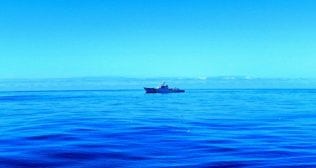Marine
-
The Young Coastal Scientists and Engineers Conference 2013
8th April 2013 by sfraser
Submitted by Jenny Wright The University of Aberdeen and Marine Scotland Science recently organised the 9th UK Young Coastal Scientists and Engineers Conference (YCSEC), with two of our oceanographers, Rory O’Hara Murray and Bee Berx, on the local organising committee. The conference was held at the University’s Fraser-Noble Building on March 25th and 26th 2013....
-
M.R.V. Temora skipper Raymond Cargill retires
17th December 2012 by sfraser
For the last ten years, sampling for the Marine Scotland Science (MSS) Coastal Ecosystem Monitoring Programme at Stonehaven has been undertaken by scientists on board the catamaran Temora. Raymond Cargill, skipper of the Temora, will be retiring at Christmas. Raymond’s local knowledge, dedication and skill will be sorely missed by MSS, as will his readiness...
-
New phytoplankton and microbe report launched
23rd October 2012 by sfraser
The International Council for the Exploration of the Sea (ICES) has launched its first phytoplankton and microbial plankton status report. This report presents data from sixty one sites and from seven geographic regions within the North Atlantic, Baltic and Mediterranean areas. It also includes forty standard areas from the continuous plankton recorder monitoring programme operated by...
-
Aberdeen Foam Event
28th September 2012 by sfraser
You may have noticed in the national press that a very unusual sea foam (or spume) event occurred this week in Aberdeen. This foam is a natural product and it is not considered a harmful event. In case you missed it, here is a news link to this extraordinary sight – http://www.bbc.co.uk/news/uk-scotland-north-east-orkney-shetland-19716141 Marine Scotland scientists...
-
New reports concerning Scottish coastal marine ecosystems
3rd September 2012 by sfraser
This summer Marine Scotland Science has published two interesting reports concerning Scottish marine ecosystems. The first is a review of previously published information concerning the Firth of Clyde ecosystem. The report has found that “while the Clyde has clearly been impacted by human activities, it supports significant quantities of fish and is demonstrating some signs...
-
Non-native Species and Biofouling
11th July 2012 by sfraser
What are Non-native Species? When species of plants and animals occur unexpectedly in areas outside their normal range they are called “non-native species”. Examples of how non-native species can be introduced to new areas are by accidentally travelling on an aeroplane or ship (e.g the black rat), or when fish or shellfish imported for the...
-
Harmful Algae in Scottish Waters
18th June 2012 by sfraser
Under certain environmental conditions, marine phytoplankton can grow very quickly and form what are called “Harmful Algal Blooms” or HABs. In some instances these natural blooms can impact the marine ecosystem by causing mortalities of animals that live on the sea bed. This may occur either directly as a result of toxins produced by the...
-
Monitoring Marine Zooplankton
4th April 2012 by sfraser
What are marine zooplankton? Zooplankton are very small animals that live in the sea. They are not strong enough to swim against tides and currents and so drift along in the water. There are tens of thousands of species of zooplankton and they range in size from being smaller than a grain of rice up...
-
Big Bang prize for student work
21st March 2012 by admin
Mairi Bell of Hazlehead Academy wowed the judges at The Big Bang National Science & Engineering Fair in Birmingham last week with her project on diagnosing embryo abnormalities in Zooplankton, which form important components of marine food webs and changes in their abundance can assess the health of the marine ecosystem.
-
Spring is coming in the water
29th February 2012 by sfraser
This week we have seen the first signs of spring in our gardens as snowdrops, crocuses and daffodils have started to shoot through the soil. In the waters surrounding our shores we are also beginning to see the first signs of spring as the phytoplankton diatom population has begun to grow too. Below are some...

